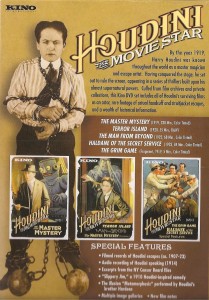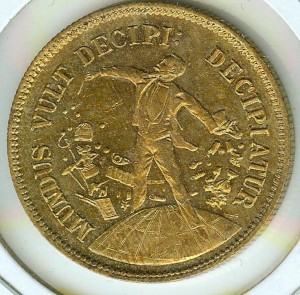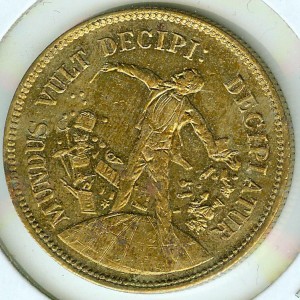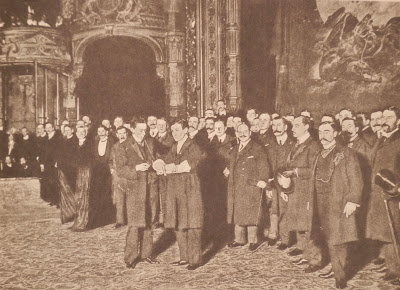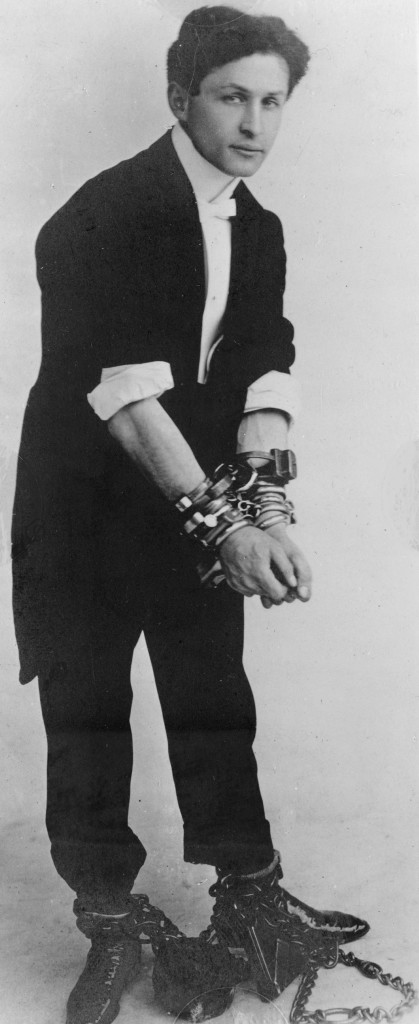
This photograph of the ‘Handcuff King’ was taken while Houdini was appearing at the London Hippodrome in 1904 – the occasion of his Mirror Challenge.
The March 17, 1904 Mirror Handcuff Challenge [click link to read a full account]
In the 1929 Sensational Tales of Mystery Men by Will Goldston:
- At the end of an hour, he asked his wife to bring him a glass of water. This she did, placing it on the edge of the cabinet. Houdini took the glass between his hands and drained it. Ten minutes later, he emerged from the cabinet and flung the handcuffs on to the stage.
In Houdini by Kenneth Silverman:
- Houdini did not reappear for another thirteen minutes [35 minute mark]. Perspiring this time, his stiff collar broken, he explained that he needed to stretch his aching knees but was determined to continue. Parker or by one account Bess gave Houdini a glass of water and [the Mirror Representative] consulted with the manager of the Hippodrome, who directed an attendant to bring a large cushion. [Note: Silverman incorrectly refers to the Mirror Representative as Parker]
In The Secret Life of Houdini by Kalush:
- Then at thirty-five minutes, Houdini emerged again. His collar was opened, and sweat poured off his face. “My knees hurt and my legs have cramped,” Houdini explained. “Please allow me to stretch them. I am not done yet.” The crowd cheered. Mr. Parker, the manager, brought Houdini a glass of water. Then the Mirror Representative conferred with Parker. Parker nodded his head and signaled to an assistant. In seconds, the assistant was back with a large cushion.
In most newspaper accounts, a glass of water is not mentioned, only the large cushion. The newspaper account that I found that mentioned the glass of water does not mention the large cushion nor does it mention who gave him the glass of water:
- After the expiry of 32 minutes he re-appeared, sweating profusely, and with his collar hanging down his back. He wanted a drink of water and having quenched his thirst, retired once more.
Many magicians assume Houdini must have had a key to the cuff. If this is true, how did Houdini get the key?
Will Goldston, writing in his Sensational Tales of Mystery in December 1929, claimed that an informant of his “whose sources of information are usually correct”, had told him that Bess smuggled it to him when she gave him a drink of water. The story goes as follows:
- Houdini never escaped from the handcuffs. After an hour’s struggling, the magician realized he would never escape. So he asked his wife for a glass of water and gave her to understand that she would have to procure the key at all costs. Bessie, realizing the terrible predicament of her husband, called one of the journalists aside, and frankly told him that her husband was beaten. Since failure would have meant the end of everything for Houdini, whilst to the paper it meant but little, she asked to be given the key to pass on to her husband. This request was granted. It was rumored that Bessie placed the key in the glass of water and took it to Houdini on the stage. Shortly afterwards, he walked from the cabinet with the handcuffs free from his wrists.
Considering the size of the Mirror Key, it would be hard to hide in a glass of water according to Kalush and Silverman; however, Handcuff Experts point out that the working area of the key is all that is required and that the key could have been cut down to a length of about 1 ½ inches. The actual nested mechanism is only about an inch from the keyhole and not deep inside the cuff lock tube.
Bringing a glass of water for Houdini to drink does figure into several of his most phenomenal escapes, including the Hodgson torturing.
The October 24, 1902 Hodgson Torturing Challenge [click link to read a full account]
In Houdini – The Key by Culliton:
- According to Richard Clegg Jr.: He guarded his little cabinet so’s nobody could tamper with it. They arranged that while he was there, if Houdini wanted anything – maybe a drink or something – he would tell my father and he’d hand it through. But his brother traveled with him, and he asked my father if he could take him a drink. My dad, said “if he wants a drink I’ll take it”, but in the end he decided to let him go up. My father followed him, though, and watched him give Houdini this tray.
- According to Myrum Carruthers: After he had been in the cabinet awhile he asked for a drink. This was taken to him by a woman (I expect his wife). A member offered to take this to him but refused. This was repeated quite a number of times.
Note: Bess and Hardeen were both nearby on the stage at the time.
In the Northern Daily Telegraph 24th October 1902:
- The crowd, however, was fast losing patience, and they loudly hooted as Hardeen, brother of Houdini, approached the cabinet to give a word of cheer, or maybe some advice, to his imprisoned relative. On receiving a refreshing drink Houdini, after again calling upon the people to have a little patience, exclaimed that every lock had been changed, and that made it all the more difficult for him to get free.
In The Secret Life of Houdini by Kalush:
- And when the brother approached the cabinet to give him a word of cheer, some of the crowd began booing. Apparently Houdini told Theo he was thirsty, because a cool glass of water was provided him. Then he addressed the audience again from his cabinet.
Comments and Questions about the Challenges
So in the mirror handcuff challenge there was a glass of water and a pillow and in the Hodgson Torture challenge there was a glass of water and a tray. In both challenges, Bess is misidentified by at least one account as bringing a glass of water to Houdini. It was Parker, in the Mirror Challenge and Hardeen in the Hodgson torturing.
All kinds of questions could be asked about either challenge. Was Houdini milking the situation, prolonging it for dramatic effect? Had Houdini colluded? Did a relative assist in the escape? And did a glass of water really have anything to do with it. We may never know the answers for sure and they may be different for each challenge.
All of this has made me thirsty for a glass of water!

